opisska
rabid twitcher

We (me and my wife) were always saying that if we at some point won't have anything better to do, we could always go to Iceland again to clean up the missing WP species we have there. Over time, this list has been shrinking and shrinking, as we were getting some of the targets elsewhere, but there was always Harlequin Duck and Barrow's Goldeneye, neither of which is regular anywhere else in WP. This year, it finally happened - we had some free time in July, but not really enough to warrant a 12-hour flight somewhere interesting, so Iceland it was - with a direct 4-hour flight from Prague (albeit at an ungodly hour at night, both ways), it was an easy decision. Besides the two ducks, we also had European Strom-Petrel planned and there was a report of a highly confused Dovekie which now spends the summers on Grímsey, which we could feasibly add to the itinerary. On top of all this, we have recently embraced the idea of whale-watching boats (mainly on account of us finally being rich enough the be able to afford them) and Iceland is one of the best places in the world to engage in this activity.
We have spent 10 days on Iceland. traveling on public transport with a little bit of hitchhiking. Even this is absurdly expensive, but still better than car rental, where even the smallest car went for about 160 EUR per day, which is, amusingly, more expensive than the Hilux we rented in Kenya! For the first half of the trip, we went to the Snaefellsness Peninsula in order to take a whale-watching tour with Laki Tours from Ólafsvík and to hike around the mountainous interior of the peninsula a bit, as we had a friend who is not much of a birder but a hiker and a big fan of whale-watching (thanks to her having a degree in marine biology), so this area was perfect to combine those activities. In this area we were not really expecting much birding success, but we did actually notice a flock of either juvenile or eclipse-plumaged Harlequin ducks from a bus between Grundarfjörður and Ólafsvík - the sighting was very brief but it really couldn't be anything else, with a uniformly dark plumage with a bright spot on the head - it helped that we have seen a similar flock a couple of years ago in Yellowstone.
The real highlight of Snaefellsness were whales. First, we have seen a very distant Humpback breaching from the absolute depths of Grundarfjörður - literally the worst place to observe whales imaginable, at the end of a very long fjord, but Humpbacks are so huge that we could clearly see it even kilometers away; later we saw several of those from much closer distance when we hiked to the tip of the Kirkjufjell peninsula, but they were not breaching anymore. The extremely pleasant Laki tours trip brought Orcas, more Humpbacks, White-beaked Dolphins and an unsatisfactory glimpse of a Minke Whale. As for birds, there was a general assortment of north Atlantic seabirds - various gulls (including Glacuous), all sorts of alcids, Gannets, Fulmars, Kittiwakes - sometimes in these huge rafts of birds in the fish-rich areas with the Humpbacks, including Manx Shearwaters (which we had never seen this nicely before). I was sometimes thinking about how funny it is that we have been slowly collecting those species over years of birding and now they are there all together in one flock. Even funnier was the thought that we have probably seen many of them in 2006, we just had no idea what we were looking at back then! Hiking inland was rather quiet, except for the numerous breeding Whimbrels, Golden Plovers and Redshanks as well as Arctic Skuas, a family of Red-necked Loons and some Red-necked Phalaropes.
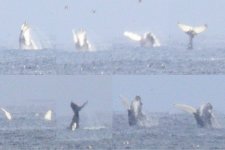
As our friend was leaving after 5 days, we were planning to travel alone to the Akureyri/Mývatn area for the second half of the trip in order to look for both of the ducks (which in summer are rare elsewhere on Iceland, especially the Goldeneye) and to take a ferry to Grímsey to look for the Dovekie and maybe for more whales from the ferry. However as this was nearing, the weather forecast for the north was getting insanely bad - now the reader has to understand that weather on Iceland is usually not "good" in the traditional sense of the word, but the north is typically the less rainy part and it can be reasonably sunny there for extended periods of time. But not this time, this time the national weather service posted warnings for gale winds and flooding - it wasn't even clear that the ferry would actually go and even if it did, the visibility was probably zero most of the time. Considering how expensive long-distance travel around Iceland is - a Reykjavík-Akureyri bus costs almost $100 per person one way! - we have cut our losses and retreated to the southern coast, where it actually was sunny for the remaining days (which is expected in periods of strong northerly winds) even if little cold and windy (around 10 degrees during the day, at the end of July) and spent some time mostly re-visiting places we have already been to, but now from a birder's viewpoint.
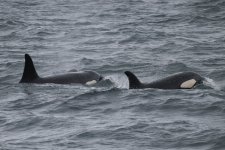
First we took another whale trip, this time from Reykjavík, to see the Minke Whales properly, which we did in copious amounts - interestingly, there were no other species at all during the 3-hour sailing. What was there though were European Storm-petrels - with really close up and nice views, as well as some even better views of Manx Shearwaters. In the harbor, someone reported a Dovekie on eBird, but when we came to the site, there was a juvenile Common Guillemot and nothing else. I don't want to sound suspicious, but I think the observer just mixed it up - and as is the general tragedy of eBird, there is no way to call them up on it ... The next day, we tried yet another eBird tip, but this time confirmed by several people - Snow Goose near Hafnarfjörður, just outside the capital. We camped in the Hafnarfjörður campsite and took a local bus to the site, where we quickly found the goose in a flock of Greylags. This is a species that sometimes occurs in the Czech Republic or Poland (we even saw one in Poland this spring), but it's never accepted as wild, not even cat. C, so we were happy to finally tick it on Iceland, where it is closer to their actual breeding range than to any private collection in Europe.
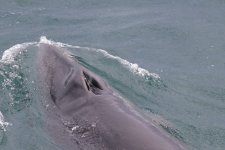
We then continued to Westmannaeyar, the cool little archipelago near the southern tip of Iceland. Since our previous visit in 2006, there was an unpleasant change - the originally 3-hour ferry has been shortened to 30 minutes thanks to a new harbor much closer to the islands, leaving much less time to watch things from the ferry. As we were arriving to this harbor, we were quite shocked by the endless sea of cars parked around it, not only in parkings, but on meadows and in ditches - and then we learned that we have picked a ... less than fortunate time for the visit, as there was a huge festival on the islands - literally every teenage alcoholic from the whole country moved there for the weekend. This also disrupted our idea of "peaceful nights on the campsite" because what we remembered as such was actually close to the center of the action and there were hundreds of tents everywhere ... well, it was a bit annoying, trying to sleep with live music and fireworks, but at least all the fuzz was contained to the festival area and the rest of the main island was basically empty as usual. We tried to watch for whales from the cliffs, with no success, and we also tried to scour various small bushes and other sheltered areas hoping for some juicy migrant songbirds, but also with no success, as everything eventually turned to be a Redwing or a Meadow Pipit.
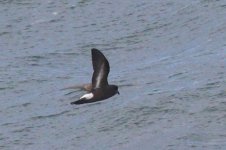
Encouraged by the Snow Goose success, we followed yet another eBird tip, a flock of 7 Barrow's Goldeneys southwest of Hveragerði at Strandakirkja (where we had to hitch-hike to). There wasn't a very specific location, but the checklist had two Long-tailed Ducks, which we eventually found, in the company of 7 .... Tufted Ducks. Considering that the checklist claimed to be complete and had no Tufted Ducks, I have a strong suspicion that this is yet another mistake. And I have again no way to put this information alongside the observation. Why the hell does eBird not allow comments on sightings? It's so stupid! But the area was nice, with a lot of Common Seals at least. We hitchhiked a bit more to the west and checked out the site of the 2021 Fagradalsfjall eruption with a huge new lava field and settled down in Grindavík. Next morning, we explored the coast around it, sadly unaware of the White-rumped Sandpiper sighting made there roughly at that time, but made publicly known only a few days later, and moved on to Garður, the north-west tip of the Reykjanes Peninsula.
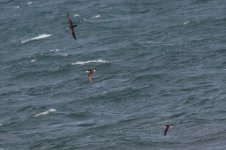
This place has also changed a little since our last visit, as the camping near the lighthouse is no longer free, but otherwise was still as lovely as we remembered it. What really surprised us though was the show the Manx Shearwaters were putting on there, flying really close to the coast - and here I was, until then, thinking that this is a difficult species to see from land! We checked all the wader flocks up and down but did not find anything unusual. It was Wednesday, August 3, and our flight was scheduled for 11 pm, so we were just loitering around killing time - when at 2 pm, someone casually told us that the volcano has erupted! Indeed, there was smoke on the horizon! So we quickly got up and run to the bus stop - after a bus, a hitch, and an energetic hike, it was 4:25 pm and I was standing at the viewpoint, 200 meters of altitude above the parking - and was cursing the stupid volcano, because it erupted from the opposite site of the 2021 lava field, at an area we had absolutely no chance to get to before the flight It was quite funny to see all the gradually more and more disappointed people, because this early into the new eruption, nobody had really any idea that it isn't visible from the old viewpoints ... well, next time!
It was quite funny to see all the gradually more and more disappointed people, because this early into the new eruption, nobody had really any idea that it isn't visible from the old viewpoints ... well, next time!
Overall we saw only 53 species of birds, but two of them were lifers (Snow Goose and Storm-petrel) and the bad sighting of Harlequin ducks is a WP tick. We also got 4 mammal ticks (all the cetaceans), so it wasn't all that bad. Next time, we really need to go to Iceland in June, to see the ducks in proper plumage, and we need to just go to the north (perhaps just fly to Akureyri?) and combine a duck-hunt with a Blue Whale safari from Húsavík.
We have spent 10 days on Iceland. traveling on public transport with a little bit of hitchhiking. Even this is absurdly expensive, but still better than car rental, where even the smallest car went for about 160 EUR per day, which is, amusingly, more expensive than the Hilux we rented in Kenya! For the first half of the trip, we went to the Snaefellsness Peninsula in order to take a whale-watching tour with Laki Tours from Ólafsvík and to hike around the mountainous interior of the peninsula a bit, as we had a friend who is not much of a birder but a hiker and a big fan of whale-watching (thanks to her having a degree in marine biology), so this area was perfect to combine those activities. In this area we were not really expecting much birding success, but we did actually notice a flock of either juvenile or eclipse-plumaged Harlequin ducks from a bus between Grundarfjörður and Ólafsvík - the sighting was very brief but it really couldn't be anything else, with a uniformly dark plumage with a bright spot on the head - it helped that we have seen a similar flock a couple of years ago in Yellowstone.
The real highlight of Snaefellsness were whales. First, we have seen a very distant Humpback breaching from the absolute depths of Grundarfjörður - literally the worst place to observe whales imaginable, at the end of a very long fjord, but Humpbacks are so huge that we could clearly see it even kilometers away; later we saw several of those from much closer distance when we hiked to the tip of the Kirkjufjell peninsula, but they were not breaching anymore. The extremely pleasant Laki tours trip brought Orcas, more Humpbacks, White-beaked Dolphins and an unsatisfactory glimpse of a Minke Whale. As for birds, there was a general assortment of north Atlantic seabirds - various gulls (including Glacuous), all sorts of alcids, Gannets, Fulmars, Kittiwakes - sometimes in these huge rafts of birds in the fish-rich areas with the Humpbacks, including Manx Shearwaters (which we had never seen this nicely before). I was sometimes thinking about how funny it is that we have been slowly collecting those species over years of birding and now they are there all together in one flock. Even funnier was the thought that we have probably seen many of them in 2006, we just had no idea what we were looking at back then! Hiking inland was rather quiet, except for the numerous breeding Whimbrels, Golden Plovers and Redshanks as well as Arctic Skuas, a family of Red-necked Loons and some Red-necked Phalaropes.

As our friend was leaving after 5 days, we were planning to travel alone to the Akureyri/Mývatn area for the second half of the trip in order to look for both of the ducks (which in summer are rare elsewhere on Iceland, especially the Goldeneye) and to take a ferry to Grímsey to look for the Dovekie and maybe for more whales from the ferry. However as this was nearing, the weather forecast for the north was getting insanely bad - now the reader has to understand that weather on Iceland is usually not "good" in the traditional sense of the word, but the north is typically the less rainy part and it can be reasonably sunny there for extended periods of time. But not this time, this time the national weather service posted warnings for gale winds and flooding - it wasn't even clear that the ferry would actually go and even if it did, the visibility was probably zero most of the time. Considering how expensive long-distance travel around Iceland is - a Reykjavík-Akureyri bus costs almost $100 per person one way! - we have cut our losses and retreated to the southern coast, where it actually was sunny for the remaining days (which is expected in periods of strong northerly winds) even if little cold and windy (around 10 degrees during the day, at the end of July) and spent some time mostly re-visiting places we have already been to, but now from a birder's viewpoint.

First we took another whale trip, this time from Reykjavík, to see the Minke Whales properly, which we did in copious amounts - interestingly, there were no other species at all during the 3-hour sailing. What was there though were European Storm-petrels - with really close up and nice views, as well as some even better views of Manx Shearwaters. In the harbor, someone reported a Dovekie on eBird, but when we came to the site, there was a juvenile Common Guillemot and nothing else. I don't want to sound suspicious, but I think the observer just mixed it up - and as is the general tragedy of eBird, there is no way to call them up on it ... The next day, we tried yet another eBird tip, but this time confirmed by several people - Snow Goose near Hafnarfjörður, just outside the capital. We camped in the Hafnarfjörður campsite and took a local bus to the site, where we quickly found the goose in a flock of Greylags. This is a species that sometimes occurs in the Czech Republic or Poland (we even saw one in Poland this spring), but it's never accepted as wild, not even cat. C, so we were happy to finally tick it on Iceland, where it is closer to their actual breeding range than to any private collection in Europe.

We then continued to Westmannaeyar, the cool little archipelago near the southern tip of Iceland. Since our previous visit in 2006, there was an unpleasant change - the originally 3-hour ferry has been shortened to 30 minutes thanks to a new harbor much closer to the islands, leaving much less time to watch things from the ferry. As we were arriving to this harbor, we were quite shocked by the endless sea of cars parked around it, not only in parkings, but on meadows and in ditches - and then we learned that we have picked a ... less than fortunate time for the visit, as there was a huge festival on the islands - literally every teenage alcoholic from the whole country moved there for the weekend. This also disrupted our idea of "peaceful nights on the campsite" because what we remembered as such was actually close to the center of the action and there were hundreds of tents everywhere ... well, it was a bit annoying, trying to sleep with live music and fireworks, but at least all the fuzz was contained to the festival area and the rest of the main island was basically empty as usual. We tried to watch for whales from the cliffs, with no success, and we also tried to scour various small bushes and other sheltered areas hoping for some juicy migrant songbirds, but also with no success, as everything eventually turned to be a Redwing or a Meadow Pipit.

Encouraged by the Snow Goose success, we followed yet another eBird tip, a flock of 7 Barrow's Goldeneys southwest of Hveragerði at Strandakirkja (where we had to hitch-hike to). There wasn't a very specific location, but the checklist had two Long-tailed Ducks, which we eventually found, in the company of 7 .... Tufted Ducks. Considering that the checklist claimed to be complete and had no Tufted Ducks, I have a strong suspicion that this is yet another mistake. And I have again no way to put this information alongside the observation. Why the hell does eBird not allow comments on sightings? It's so stupid! But the area was nice, with a lot of Common Seals at least. We hitchhiked a bit more to the west and checked out the site of the 2021 Fagradalsfjall eruption with a huge new lava field and settled down in Grindavík. Next morning, we explored the coast around it, sadly unaware of the White-rumped Sandpiper sighting made there roughly at that time, but made publicly known only a few days later, and moved on to Garður, the north-west tip of the Reykjanes Peninsula.

This place has also changed a little since our last visit, as the camping near the lighthouse is no longer free, but otherwise was still as lovely as we remembered it. What really surprised us though was the show the Manx Shearwaters were putting on there, flying really close to the coast - and here I was, until then, thinking that this is a difficult species to see from land! We checked all the wader flocks up and down but did not find anything unusual. It was Wednesday, August 3, and our flight was scheduled for 11 pm, so we were just loitering around killing time - when at 2 pm, someone casually told us that the volcano has erupted! Indeed, there was smoke on the horizon! So we quickly got up and run to the bus stop - after a bus, a hitch, and an energetic hike, it was 4:25 pm and I was standing at the viewpoint, 200 meters of altitude above the parking - and was cursing the stupid volcano, because it erupted from the opposite site of the 2021 lava field, at an area we had absolutely no chance to get to before the flight
Overall we saw only 53 species of birds, but two of them were lifers (Snow Goose and Storm-petrel) and the bad sighting of Harlequin ducks is a WP tick. We also got 4 mammal ticks (all the cetaceans), so it wasn't all that bad. Next time, we really need to go to Iceland in June, to see the ducks in proper plumage, and we need to just go to the north (perhaps just fly to Akureyri?) and combine a duck-hunt with a Blue Whale safari from Húsavík.








